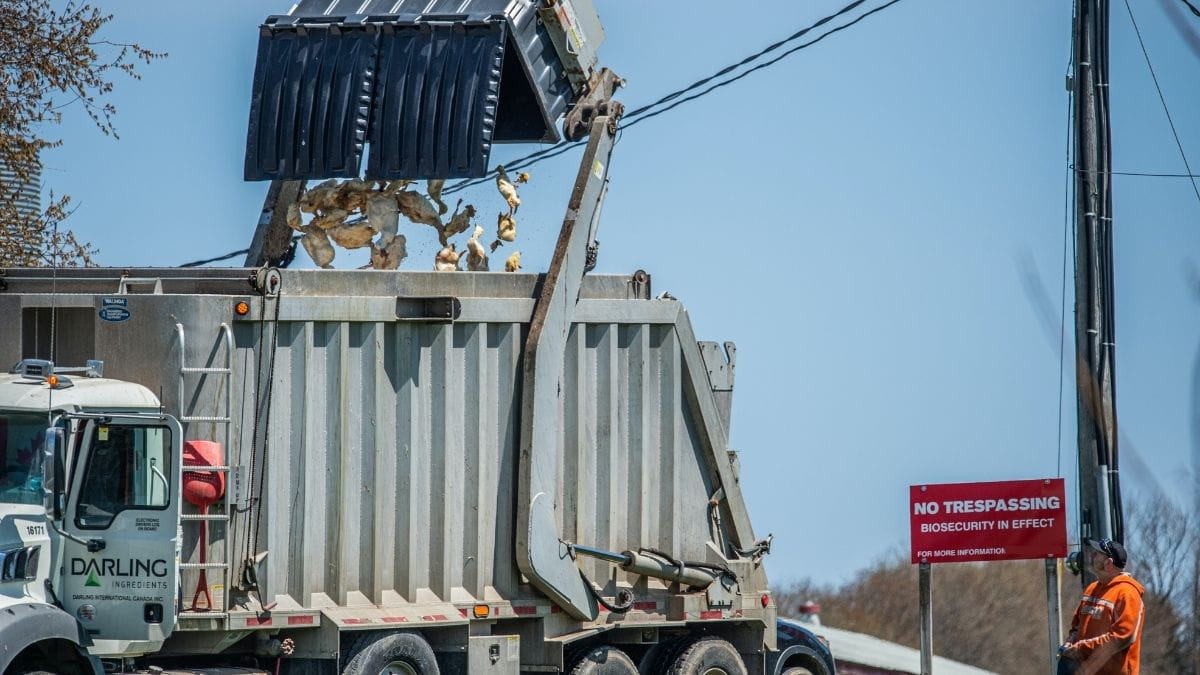
In early 2023, hundreds of dead sea lions washed up on the shores of Peru. In the UK, researchers have been finding dead fox and otters with no apparent cause of death. Last fall, a mink farm in Spain was forced to cull every one of its 50,000 animals. The culprit: bird flu.
Avian influenza, specifically the H5N1 viral subtype, has been causing waves of infection and mass death in wild birds and poultry since it was first characterized in 1996. But what’s troubling the public health community is that the virus is now infecting mammals. In the US too, H5N1 has infected a dozen species, including raccoons, foxes, seals and grizzly bears. These animals likely contracted the virus by eating an infected bird. But on the mink farm, it appears the virus was transmitted among the mink, a troubling sign of a virus evolving the ability to spread between individuals of the same species.
We spoke with Julie Vaishampayan, MD-MPH, who served as public health officer in Stanislaus County, California from 2017 till 2022 and who chaired the public health committee of the Infectious Disease Society of America (during the pandemic or 2019-2022), about this new and emerging threat:
Q. The dead animals are troubling enough, how much of a threat to humans is bird flu?
A. The H5N1 subtype has evolved to spread more easily in birds, but it doesn’t always kill them. If they are able to fly around, they can spread it more widely and that’s what we are seeing now. We all have different receptors than birds on our cells. Currently H5N1 has not gained the ability to bind to human cells in the upper respiratory tract, which is great news. We don’t like it when we see bird flu strains start to infect mammals. But I would say the current risk to people is low. We’ve seen a lot of animal spread. But what’s absolutely amazing is how few people have been infected.
Q. Do you mean the people who work directly on poultry farms?
A. Yes, but also others, golfers for example. If you think about the huge numbers of Canadian geese and the amount of fecal material that’s all over golf courses, we just haven’t seen any infections in golfers. Neither have we seen any in hunters that I’m aware of. If H5N1 were able to readily infect humans, we’d be seeing a lot more cases. There have only been a handful of documented human cases, primarily in people who work on animal farms. The potential is still there, but it has not gained that ability currently. But we continue to watch it.
Q. What drives viral evolution? Or a virus to jump species?
A. After the past few years, I think the public has a very good understanding that viruses change all the time. When they reproduce, they are not very accurate, especially RNA viruses like H5N1 and coronaviruses. They make mistakes, which sometimes hurt the virus, sometimes do nothing and other times give the virus an advantage, depending on the environment it’s in. If a genetic change just happened to give H5N1 the ability to bind to human respiratory cells, for example, and there was a situation where the infected animal was around a lot of humans, it would spread. But if animals that carried that mutated virus never came into contact with people, it wouldn’t be passed to humans. So there is an environmental component too that can lead to a virus infecting another species, not just genetic changes in the virus.
Q. What are other examples of animal viruses infecting people, or zoonotic diseases?
A. They are so many. Around 60% of all infectious diseases in humans can be transmitted from animals. It’s just huge. Some of the common ones are Salmonella from chickens and E. coli from beef, rabies, plague, Lyme disease, malaria.
Q. We tend to forget about these because they are treatable and don’t usually kill.
A. Yes, and people don’t realize how much effort goes into keeping our food sources safe. Norovirus, for example, can whip through places. The mode of transmission is fecal to oral and it takes so little of it to infect people. When we see really large outbreaks, it’s often a food handler who didn’t wait 24 hours after having a bout of diarrhea to return to work. There’s a lot of talk whether norovirus can be transmitted airborne. We treat it like a biohazard. It’s just so infectious. A plume of vomit can land on your hands. It’s just unbelievable how easily norovirus can spread.
Q. But these types of infections don’t tend to become epidemics. What causes something to turn into an epidemic or a pandemic?
A. Often there needs to be asymptomatic spread. We were able to stop the first SARS outbreak in 2003 because it was primarily spread only after symptoms appeared. Once someone gets sick, they don’t tend to go out. But if you are able to spread it before you get symptoms, that makes it harder to find and stop the spread. HIV, Chlamydia, and herpes can also spread asymptomatically, which is one reason they are still with us.
Q. The 1918 influenza pandemic is estimated to have killed 100 million people worldwide. What made it so deadly?
A. It does seem like it was a pretty lethal virus, even though world travel was not nearly as accessible as it is today. There were no treatments such as anti-virals back then and no modern hospitals. There were no ventilators and no ICUs. People’s general health was not as good. They had a lot of nutritional deficiencies, which isn’t good for fighting infections. It spread around the world more slowly than the SARS-CoV-2 viruses, but there were far fewer ways to help people who became sick.
Q. That was more than a century before the coronavirus pandemic. Are there global factors that make another zoonotic epidemic more likely in the near future?
A. The population has grown so much and we are cutting down trees and grasslands and we are encroaching into different habitats. People are coming into contact with more animals and increasing the likelihood of transmitting diseases that we did not know before. I don’t have a solution for this issue, but it is extremely important. It is a global concern.
Q. How are public health researchers surveilling the spread and evolution of bird flu?
A. Once an infection in a commercial flock is identified, public health monitors all people who are exposed. If someone gets sick, they get tested. In the US that is happening everywhere. With backyard flocks, we try to work with them too. Monitoring infections in people from wild birds is much more difficult. We mostly do it through communication. It’s important for people who come into contact with wild birds to be aware that they can get sick from handling the birds, dead or alive. If they have been exposed and become ill, they should notify the public health authorities. There are also surveillance measures in place for testing dead wild animals for infections, but that’s not my area of expertise.
Q. Based on our experience with the coronavirus, what can we do better to prevent bird flu from becoming the next epidemic?
A. We are already so far ahead. The first identification of the coronavirus happened when it was already spreading in people. We didn’t have any treatments or tests. We were already behind because it hadn’t been known beforehand. With bird flu, the CDC has already been looking into updating an existing vaccine and preparing in advance. We already have tests and we have influenza therapeutics and we are monitoring people who are exposed. But we do need to make more people aware that it’s here and spreading and that they need to tell public health authorities if they have been exposed and become ill, that they should wear gloves and masks and even goggles when handling sick or dead animals and wash their hands.
Q. Is there a way to prevent or circumvent zoonoses in general?
A. Frequent and thorough hand washing or hand sanitizing when water is not available can go a long way in preventing zoonoses in people. Keeping hands away from your eyes, nose and mouth. Taking all your recommended vaccines, stay away from sick or dead animals, if you can. Don’t take them home and try and rehabilitate them. Keeping our animals up to date with vaccines also helps.
Q. Is there any new technology that can play a role in prevention?
A. With DNA sequencing and other types of molecular testing we aren’t restricted to merely identifying flu A from flu B anymore. We can now look at pathogens in so much more detail. Where is the receptor binding area? Can this pathogen can bind to human receptors? We can answer those questions now. Our technology has improved in leaps and bounds.
Q. What about other modes of prevention?
A. Some researchers are looking into new vaccines for birds and other animals. An example is a government program to prevent raccoons from spreading rabies westwards. Vaccines packaged in raccoon food are dropped via aircraft along the Appalachian Mountains. As far as I know, it has worked. I think there is more like that to come. Wastewater surveillance is also being used more widely now and there has been talk of surveilling wastewater from airplanes to monitor travel related infectious diseases. But we absolutely need more treatments.
Q. Are you optimistic about our ability to learn from mistakes of the past to better prepare or circumvent the next epidemic?
A. I get frustrated when people blame the public health system for all the failures during the coronavirus pandemic. Everyone has a role to play, whether it’s the federal government, legislators, public health officials, or the public. We all need to look at what went wrong and make improvements. It takes a coordinated response and it’s really up to everybody. We need to be clear about roles and responsibilities. And we did do some things very well. The federal vaccine initiative was phenomenal. We just have to be honest about what worked and improve things that didn’t. We learned a lot and I am optimistic that should there be another epidemic in the near or distant future, our response will be better.
July 2023

Julie Vaishampayan has served in California as the health officer for Stanislaus County, the assistant health officer for San Joaquin County, and chief of the communicable disease emergency response Branch at the California Department of Public Health, and in Michigan as the medical director for Oakland County Health Division. She chaired the public health committee of the Infectious Disease Society of America from 2019 to 2022. Although she is retired from her position as public health officer as of this year and chair of the IDSA committee, she remains an active member of several public health committees on both state and national levels.



